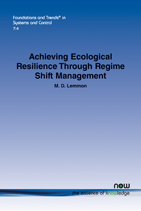Achieving Ecological Resilience Through Regime Shift Management
By M. D. Lemmon, Department of Electrical Engineering, University of Notre Dame, USA, lemmon@nd.edu
Abstract
Resilience has come to mean several things in the system sciences. The term is used to describe systems whose function is robust with respect to external disturbances. It is used to describe systems that tolerate faults in some internal component. It is also used to describe systems that have the capacity to recover after a complete collapse of system function. This monograph defines resilience in the last sense. This notion of resilience is often calledecological resilience. For a system to be ecologically resilient, one first accepts system collapse as being inevitable and then requires that the resources for subsequent system recovery be buried in the wreckage of that collapse.
The ecological concept of aregime shift plays an important role in describing abrupt shifts in ecosystem behavior. In particular, the collapse of system function may be seen as an instance of a regime shift. Restoring a collapsed ecosystem often involves walking the system through a sequence of alternative states before full recovery can be achieved. The transitions between these alternative states are also regime shifts. But in this case, these regime shifts are purposefully triggered to speed up the recovery process. Managing regime shifts that trigger system collapse provides a way toconserve existing system function. Managing regime shifts that systematically rebuild lost system function provides a way torestore lost system function. Regime shifts, therefore, play an important role in enhancing the ecological resilience of a dynamical system.
This monograph formalizes the ecologist’s regime shift concept by identifying regimes with components (also known as basic sets) of a Morse decomposition of the system’s chain recurrent set. This formalization allows the identification of two distinct regime shift mechanisms; one triggered by external shocks (shock-induced regime shift) and the other triggered by bifurcations of the system flow (bifurcation-induced regime shift). This allows one to define ecological resilience in terms of a discrete abstraction (called theregime transition system) that characterizes the sequences of shock-induced regime shifts that can be triggered in the system. This monograph shows how that transition system can be constructed from the system’s differential equation model and demonstrates how it can be used to enhance the resilience of ecosystem foodwebs through the careful management of the system’s regime shifts.
Achieving Ecological Resilience Through Regime Shift Management
Ecological resilience describes systems that have the capacity to recover after a complete collapse of system function. For a system to be ecologically resilient, system collapse is accepted as being inevitable and requires that the resources for subsequent system recovery be buried in the wreckage of that collapse.
The ecological concept of a regime shift plays an important role in enhancing the ecological resilience of a dynamical system. Managing regime shifts that trigger system collapse provides a way to conserve existing system function. Managing regime shifts that systematically rebuild lost system function provides a way to restore lost system function.
In this monograph, the author formalizes the ecologist’s regime shift concept that allows the identification of two distinct regime shift mechanisms, shock-induced and bifurcation-induced regime shift, before defining ecological resilience as a regime transition system. The author takes the reader through the theoretical concepts in a tutorial nature and goes on to demonstrate practical applications of the theory.
Written in a clear and accessible manner, this monograph is an illuminating introduction to a topic that has increasing importance in modern systems. This is important reading for both researchers and practitioners.
